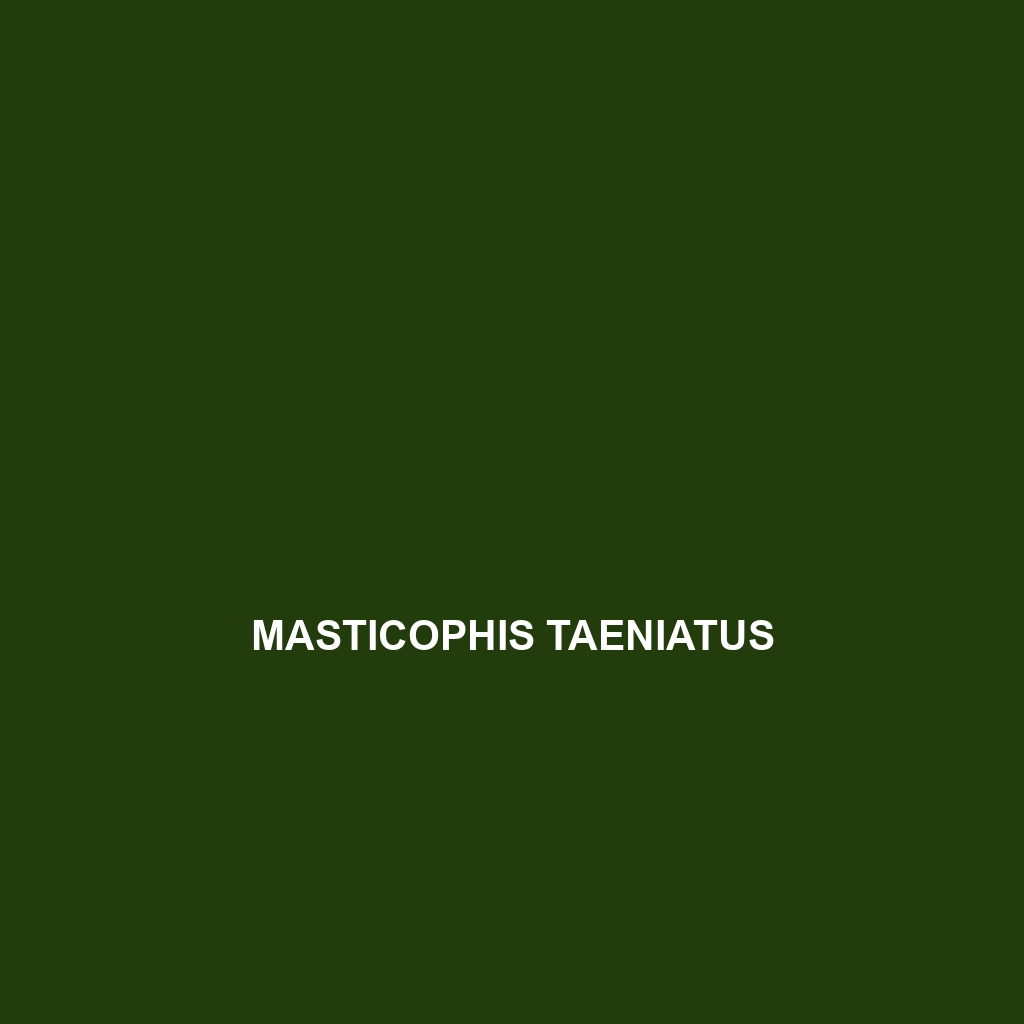Common Name
Masticophis taeniatus
Scientific Name
Masticophis taeniatus
Habitat
Masticophis taeniatus, commonly known as the striped whipsnake, is primarily found in the arid to semi-arid regions of North America, particularly in the southwestern United States and northern Mexico. Its preferred habitats include vast stretches of desert, rocky hillsides, and scrublands. This species is adept at thriving in environments characterized by low vegetation and an abundance of sun exposure. Additionally, Masticophis taeniatus can occasionally be found in grasslands and temperate forests interfacing these deserts, demonstrating adaptability to diverse climatic conditions. The ability to thrive in varying terrains contributes to its extensive geographic distribution.
Physical Characteristics
Masticophis taeniatus exhibits distinctive physical traits that make it easily recognizable among other snakes. Typically reaching lengths of 3 to 6 feet, this snake features a slim, elongated body with a pointed head. Its coloration usually consists of a mix of black, brown, and olive with three prominent dorsal stripes, which are light-colored. The underbelly is generally lighter, often a pale yellow or white. The smooth scales and streamlined shape assist in rapid movements, allowing this snake to escape predators effectively. Additionally, its large, expressive eyes provide excellent visibility, an essential adaptation for its predominantly diurnal lifestyle.
Behavior
Known for its energetic and fast-paced nature, Masticophis taeniatus often engages in typical diurnal behaviors, basking in the sun during the morning before hunting. This species demonstrates a unique form of hunting known as “ambush predation,” where it waits stealthily for its prey to come within striking distance. Social interactions among these snakes are minimal; however, they are known to be solitary creatures that establish clear territories. During mating seasons, male whipsnakes engage in courtship rituals that include intricate displays and wrestling. Remarkably, they also exhibit some degree of tolerance towards each other, particularly in areas abundant with resources.
Diet
As an opportunistic carnivore, Masticophis taeniatus primarily preys on small mammals, lizards, and occasionally birds. Its diet may include a variety of other small vertebrates, showcasing its adaptability in feeding habits. The striped whipsnake employs its speed and agility to hunt, often using ambush techniques to capture unsuspecting prey. This species displays a preference for hunting during the cooler parts of the day or after sunset, exhibiting a level of nocturnal behavior while still being mostly diurnal. The diverse diet plays a critical role in controlling rodent populations in its habitat, thereby contributing to ecological balance.
Reproduction
The reproductive cycle of Masticophis taeniatus occurs in the spring, coinciding with the warming temperatures of their habitats. Mating takes place shortly after the emergence from hibernation, with females laying clutches of 5 to 20 eggs in moist, sheltered locations. The gestation period occurs approximately two months after mating, whereupon the young hatchlings emerge as fully developed and independent snakes. Parental care is minimal to nonexistent; once laid, the eggs are left to incubate on their own. Hatchlings are usually about 12 to 15 inches long and are vulnerable to predation until they reach maturity, which can take up to two years.
Conservation Status
Currently, Masticophis taeniatus is classified as “Least Concern” according to the International Union for Conservation of Nature (IUCN). However, habitat loss due to urban development and agricultural practices poses a potential threat to local populations. Conservation efforts are focused on habitat preservation and research to monitor population dynamics. Local and state wildlife agencies advocate for sustainable land use practices to mitigate habitat destruction and ensure the long-term survival of this species in its native range.
Interesting Facts
One particularly interesting fact about Masticophis taeniatus is its unique defensive behavior when threatened. Instead of relying solely on camouflage or retreat, it can emit a hissing sound by expelling air through its throat, which may deter potential predators. Another remarkable aspect of this species is its adaptability to both diurnal and nocturnal hunting, allowing it to exploit a wide range of food sources. Furthermore, the vibrant colors and patterns of this snake can vary significantly based on geographic location, leading to a diversity of appearances among populations.
Role in Ecosystem
Masticophis taeniatus plays a vital role in the ecosystems it inhabits, primarily as a predator. By regulating the populations of small mammals and reptiles, this species contributes to the balance of its natural environment. Understanding its interactions with prey and competition helps underscore its importance within the food web. Moreover, as a prey item for larger predators such as raptors and mammals, it serves as a component of the broader ecological landscape. Maintaining healthy populations of Masticophis taeniatus is essential for sustaining biodiversity and the overall health of its ecosystems.
